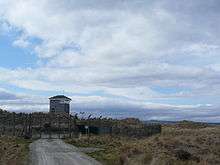RAF Tain
| RAF Tain | |||||||||||
|---|---|---|---|---|---|---|---|---|---|---|---|
| Near Tain, Ross and Cromarty in Scotland | |||||||||||
 RAF Tain Shown within Ross and Cromarty | |||||||||||
| Coordinates | 57°48′40″N 003°58′24″W / 57.81111°N 3.97333°WCoordinates: 57°48′40″N 003°58′24″W / 57.81111°N 3.97333°W | ||||||||||
| Type | Royal Air Force Air weapons range | ||||||||||
| Site information | |||||||||||
| Owner | Ministry of Defence | ||||||||||
| Operator | Royal Air Force | ||||||||||
| Site history | |||||||||||
| Built | 1930 | ||||||||||
| In use |
1930-1950 Unknown-present | ||||||||||
| Airfield information | |||||||||||
| Elevation | 5 metres (16 ft) AMSL | ||||||||||
| |||||||||||
RAF Tain is a Ministry of Defence air weapons range on the Moray Firth near Tain in Scotland. Royal Air Force aircrews from RAF Lossiemouth are trained in air weaponry on the range, along with NATO aircrew.[1]
History
The following units were posted to the airfield at some point during the Second World War:
- No. 17 Squadron RAF.[2]
- No. 76 Squadron RAF.[3]
- No. 86 Squadron RAF.[4]
- No. 123 Squadron RAF.[5]
- No. 132 Squadron RAF.[6]
- No. 144 Squadron RAF.[7]
- No. 186 Squadron RAF.[8]
- No. 235 Squadron RAF.[9]
- No. 279 Squadron RAF.[10]
- No. 280 Squadron RAF.[10]
- No. 281 Squadron RAF.[10]
- No. 311 Squadron RAF.[11]
- No. 404 Squadron RAF.[12]
- No. 415 Squadron RAF.[13]
- No. 417 Squadron RAF.[14]
- No. 455 Squadron RAF.[15]
- No. 518 Squadron RAF.[16]
- No. 519 Squadron RAF.[16]
- No. 547 Squadron RAF.[17]
- 801 Naval Air Squadron.[18]
- 815 Naval Air Squadron.[18]
- 817 Naval Air Squadron.[18]
- 822 Naval Air Squadron.[18]
- 829 Naval Air Squadron.[18]
- No. 1 Torpedo Refresher School.[18]
- No. 1 Torpedo Training Unit.[18]
- No. 4 (Coastal) OTU.[18]
- No. 8 Air Gunnery School.[18]
- No. 19 (Pilots) Advanced Flying Unit.[18]
- No. 1491 (Target Towing) Flight.[18]
- Coastal Command Development Unit.[18]
- Coastal Command Flying Instructors School.[18]
- Coastal Command Instructors School.[18]
Current use

The original airfield is no longer in operation, but still exists within the boundaries of the range.[1] The current station is the largest live weapons range in the Defence Training Estates.[1] It was one of only three ranges in Europe where live 1,000-pound (450 kg) bombs may be dropped (the others are Cape Wrath (RN) and Otterburn (Army)), and thus crucial to the final certification of bomber pilots. Several Second World War airfield buildings in various states of decay can be seen from the road to Inverness and Portmahomack.
RAF Tain is now under the control of DTE (Defence Training Estates). The range has no live bombing as it is all done at the Cape Wrath range in the far northwest of Scotland at Durness. The weapons at Tain are 3 kilograms (6.6 lb) and 14 kilograms (31 lb) practice bombs and inert 1,000 lb concrete bombs. The Americans have in the past dropped BDU-39 and -50s and some inert 500-pound (230 kg) bombs. Trainee pilots of No. 15 Squadron OCU (Operational Conversion Unit) from RAF Lossiemouth make use of the range, and it is available to aircrews from across the United Kingdom. The OCU use Tain to practice various types of attack from loft, dive and level from 250 feet (76 m) up to 15,000 feet (4,600 m). It is also an important range for UK Forward Air Controllers and their NATO counterparts to maintain their air weapons qualifications.
There are various bombing targets spread throughout the range, including strafe targets. The range is staffed by RAF controllers and assistants from QinetiQ, both of whom also man the Cape Wrath range.
As a Royal Naval Air Station, it was also known as RNAS Tain.
References
Citations
- 1 2 3 "RAF Tain - Range Activity". Royal Air Force. 2011. Retrieved 4 July 2011.
- ↑ Jefford 1988, p. 30.
- ↑ Jefford 1988, p. 48.
- ↑ Jefford 1988, p. 51.
- ↑ Jefford 1988, p. 58.
- ↑ Jefford 1988, p. 59.
- ↑ Jefford 1988, p. 61.
- ↑ Jefford 1988, p. 66.
- ↑ Jefford 1988, p. 75.
- 1 2 3 Jefford 1988, p. 83.
- ↑ Jefford 1988, p. 85.
- ↑ Jefford 1988, p. 89.
- ↑ Jefford 1988, p. 90.
- ↑ Jefford 1988, p. 91.
- ↑ Jefford 1988, p. 93.
- 1 2 Jefford 1988, p. 95.
- ↑ Jefford 1988, p. 97.
- 1 2 3 4 5 6 7 8 9 10 11 12 13 14 "Tain". Airfields of Britain Conservation Trust. Retrieved 18 October 2013.
Bibliography
- Jefford, C.G, MBE, BA, RAF (Retd). RAF Squadrons, a Comprehensive Record of the Movement and Equipment of all RAF Squadrons and their Antecedents since 1912. Shrewsbury, Shropshire, UK: Airlife Publishing, 1988. ISBN 1-84037-141-2.
External links
| Wikimedia Commons has media related to RAF Tain. |
- Official website
- Comprehensive illustrated details
- Illustrated details
- grid reference NH828818 (airfield)
- Secret Scotland - RAF Tain
